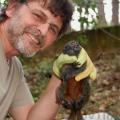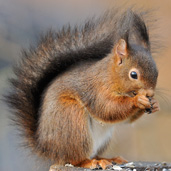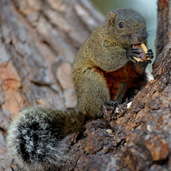Crédits
Réalisation du site
 Jean-Louis Chapuis, avec la collaboration de Anne Dozières et Benoit Pisanu
Jean-Louis Chapuis, avec la collaboration de Anne Dozières et Benoit Pisanu
Muséum National d’Histoire Naturelle
Département Homme et Environnement
Centre d'Ecologie et des Sciences de la Conservation
UMR 7204 MNHN-CNRS-P6
61 rue Buffon, CP 53
75231 Paris cedex 05
Contact : ecureuilsEFFACER@mnhn.fr
Référence du site
Si vous souhaitez citer le site "Les écureuils en France" dans vos références, merci de l'indiquer comme suit :
Chapuis, J.-L., Dozières, A. & Pisanu, B. (2012). Les écureuils en France. https://ecureuils.mnhn.fr, Muséum National d’Histoire Naturelle, Paris (consulté le....).
Principaux collaborateurs associés aux programmes de recherche du MNHN sur les Sciuridés en France
- Emmanuelle Baudry, Université Paris sud, Orsay ;
- Jean-Claude Beaucournu, Faculté de Médecine de Rennes ;
- Franck Basset, Office National des Forêts, Lons-le-Saunier ;
- Richard Bellanger, Institut National de Recherche Agronomique, Antibes ;
- Sarah Bonnet, Institut National de Recherche Agronomique, Maisons-Alfort ;
- Catherine Ducatillon, Institut National de Recherche Agronomique, Antibes ;
- Elisabeth Ferquel, Institut Pasteur, Paris ;
- Olivier Gerriet, Muséum d’Histoire Naturelle de Nice ;
- Sébastien Laguet, Office National des Forêts, La Motte-Servolex ;
- Vincent Liardet, Service "Environnement", Istres ;
- Andrey Lissovsky, Zoological Museum of Moscow, Russie ;
- Bernadette Lizet, Muséum National d’Histoire Naturelle, Paris ;
- Olivier Lorvelec, Institut National de Recherche Agronomique, Rennes ;
- Ekaterina Obolenskaya, Zoological Museum of Moscow, Russie ;
- Benoît Pisanu, Muséum National d’Histoire Naturelle, Paris ;
- Denis Réale, Université du Québec à Montréal, Canada ;
- Alexandre Robert, Muséum National d’Histoire Naturelle, Paris ;
- Guy Spagnol, Office National des Forêts, Etiolles ;
- Jan Stuyck, Instituut voor Natuur-en Bosonderzoek, Brussel, Belgique ;
- Sophie Thibault, Université Paris sud, Orsay ;
- Laurent Tillon, Office National des Forêts, Paris ;
- Gwenaël Vourc’h et son équipe, Institut National de Recherche Agronomique, Clermont-Ferrand ;
- Luc Wauters et son équipe, Université de Varèse, Italie.
Etudiants
- en doctorat : Anne Dozières, Christie Le Cœur, Julie Marmet, Maud Marsot
- en EPHE : Sébastien Laguet
- en Master 1 et 2 : Floriane Bart, Fiona Bastelica, Axelle Bouiges, Aude Bourgeois, Nelly Boyer, Cecile Delporte, Mathilde Deves, Anne Dozières, Cindy Huchery, Christelle Jérusalem, Stefaniya Kamenova, Carole Lapeyre, Lise Lebailleux, Christie Le Cœur, Julien Loiselay, Julie Marmet, Caroline Mougne, Alexandra Pinelle, Célia Rézouki, Marina Roussel, Aurore Sage, Martin Thibault
Associations, Parc national
- SOS Ecureuils et Espèces Sauvages (D. Baillie)
- Société Française pour l’Étude et la Protection des Mammifères
- Coordination mammalogique du Nord de la France
- Groupe d'Etude des Mammifères de Lorraine
- Groupe d'Etude et de Protection des Mammifères d'Alsace
- Groupe Mammalogique d'Auvergne
- Groupe Mammalogique Breton
- Groupe Mammalogique Normand
- Groupe Mammalogique et Herpétologique de Bourgogne et la Société d’Histoire Naturelle d’Autun
- Groupe Mammalogique et Herpétologique du Limousin
- Parc National de la Guadeloupe (Guy Van Laere et Hervé Magnin)
Partenaires Financiers
Site réalisé avec le soutien financier du Ministère en charge de l’écologie.
Partenaires subventionnant les recherches sur les Sciuridés :
- Conseil départemental des Hauts-de-Seine (Tamia de Sibérie : 2006-2009) (Écureuil roux : 2012-2015) ;
- Conseil régional d’Ile-de-France (Tamia de Sibérie – maladie de Lyme : 2004-2011) ;
- Ministère en charge de l’écologie (Écureuil roux, PNL Écureuil de Pallas : 2009-2021) ;
- Office National des Forêts (Tamia de Sibérie – Écureuil roux : 2004-2015).
CrÉation du site
- Le Tilleul sur la colline, conception graphique et rédaction des contenus vulgarisés ;
- WAIPdesign, conception, intégration et développement.
- Monkfish, intégration et développement.
Travaux de l'équipe du MNHN
Articles :
- BEAUCOURNU, J.C., PISANU, B. & CHAPUIS, J.-L. (2008). Enderleinellus tamiasis Fahrenholz, 1916 (Anoploura : Enderleinellidae), espèce importée, implantée et nouvelle pour la Faune de France. Parasite, 15 : 175-178. Télécharger cet article.
- BONNET, S., CHOUMET, V., MASSEGLIA, S., COTTE, M., FERQUEL, E., LILIN, T., MARSOT, M., CHAPUIS, J.-L., VOURC'H, G. (2015). Infection of Siberian chipmunks (Tamias sibiricus barberi) with Borrelia sp. reveals a low reservoir competence under experimental conditions. Ticks and Tick-borne Diseases 6:393-400. Télécharger cet article.
- BOYER, N., REALE, D., MARMET, J., PISANU, B. & CHAPUIS, J.-L. (2010). Personality, space use, and tick load in an introduced population of Siberian chipmunks, Tamias sibiricus. Journal of Animal Ecology, 79: 538-547. Télécharger cet article.
- CHAPUIS, J.-L. (2005). Répartition en France d’un animal de compagnie naturalisé, le Tamia de Sibérie (Tamias sibiricus). Revue d’Ecologie (Terre Vie), 60 : 239-253. Télécharger cet article.
- CHAPUIS, J.-L., FERQUEL, E., PATEY, O., VOURC’H, G. & CORNET, M. (2010). Borréliose de Lyme : situation générale et conséquences de l’introduction en Ile-de-France d’un nouvel hôte, le tamia de Sibérie. Bulletin épidémiologique hebdomadaire, Hors-série, 14 sept. 2010, 6-8. Télécharger cet article.
- CHAPUIS, J.L., GERRIET, O., LOSINGER-CHABOD, I., PISANU, B. (2018). Gestion d'espèces exotiques envahissantes : le cas des écureuils en France. Faune sauvage, n°321, 45-51. Télécharger cet article
- CHAPUIS, J.-L., OBOLENSKAYA, E., PISANU, B. & LISSOVSKY, A. (2009). Datasheet on Tamias sibiricius. CABI, Wallingford, UK. http://www.cabi.org/isc.
- DOZIERES, A., CHAPUIS, J.-L., THIBAULT, S. & BAUDRY, E. (2012). Genetic structure of the French red squirrel populations : implication for conservation. PLoS ONE, 7(10):e47607. Télécharger cet article.
- DOZIERES, A., PISANU, B., GERRIET, O., LAPEYRE, C., STUYCK, J. & CHAPUIS, J.-L. (2010). Macroparasites of Pallas’s squirrels, Callosciurus erythraeus, introduced into Europe. Veterinary Parasitology, 172: 172-176. Télécharger cet article.
- DOZIERES, A., PISANU B., KAMENOVA, S., BASTELICA, F., GERRIET, O., CHAPUIS J.-L. (2015). Range expansion of Pallas's squirrel (Callosciurus erythraeus) introduced in southern France: habitat suitability and space use. Mammalian Biology, 80: 518–526. Télécharger cet article.
- JACQUOT, M., ABRIAL, D., GASQUI, P., BORD, S., , MARSOT, M., MASSEGLIA, S., PION, A., POUX, V., ZILLIOX, L., CHAPUIS, J.-L., VOURC’H, G., & BAILLY, X. (2016). Multiple independent transmission cycles of a tick-borne pathogen within a local host community. Scientific Reports, 6: 31273. Télécharger cet article.
- JACQUOT, M., BISSEUX, M. ABRIAL, D., MARSOT, M., FERQUEL, E. CHAPUIS, J.-L., VOURC'H, G., BAILLY, X. (2014). High-throughput sequence typing reveals genetic differenciation and host specialization among populations of the Borrelia burgdorferi species complex that infect rodents. PLoS ONE, 9(2):e88581. Télécharger cet article.
- LE CŒUR, C., CHANTEPIE, S., PISANU, B., CHAPUIS, J.-L., ROBERT, A. (2016). Inter-annual and inter-individual variations in survival exhibit strong seasonality in a hibernating rodent. Oecologia, 181: 795–807. Télécharger cet article.
- LE CŒUR, C., PISANU, B., CHAPUIS, J.-L., ROBERT, A. (2018). Within- and between-year variations of reproductive strategy and cost in a population of Siberian chipmunks. Oecologia 188:765-776.
- LE CŒUR, C., ROBERT, A., PISANU, B., CHAPUIS, J.-L. (2015). Seasonal variation in infestations by Ixodids on Siberian chipmunks: effects of host age, sex and birth season. Parasitology Research 114:2069-78. Télécharger cet article.
- LE CŒUR, C., THIBAULT, M., PISANU, B., THIBAULT, S., CHAPUIS, J.-L., BAUDRY, E. (2015). Temporally fluctuating selection on a personality trait in a wild rodent population. Behavioral Ecology, 26:1285-1291. Télécharger cet article.
- LORVELEC, O., PASCAL, M., DELLOUE, X. & CHAPUIS, J.-L. (2007). Les mammifères terrestres non volants des Antilles françaises et l’introduction récente d’un écureuil. Revue d’Écologie (Terre Vie), 62 : 295-314. Télécharger cet article.
- MARMET, J. & CHAPUIS, J.-L. (2007). Répartition de l’Ecureuil de Corée (Tamias sibiricus), animal de compagnie exotique introduit en France : résultats de l’enquête nationale de 2005. Pp : 27-31, in : L. TILLON (ed), Les mammifères forestiers, 28ème Colloque de la SFEPM, 21-23 octobre 2005, Rambouillet (78), Collection dossiers forestiers, n° 18. Télécharger cet article.
- MARMET J., PISANU, B. & CHAPUIS, J.-L. (2009). Home range, range overlap and site fidelity of introduced Siberian chipmunks in a suburban French forest. European Journal of Wildlife Research, 55: 497-504. Télécharger cet article.
- MARMET, J., PISANU, B. & CHAPUIS, J.-L. (2011). Natal dispersal of introduced Siberian chipmunks, Tamias sibiricus, in a suburban forest. Journal of Ethology, 29: 23-29. Télécharger cet article.
- MARMET, J., PISANU, B., CHAPUIS, J.-L., JACOB, G. & BAUDRY, E. (2012). Factors affecting male and female reproductive success in a chipmunk (Tamias sibiricus) with a scramble competition mating system. Behavioral Ecology and Sociobiology, 66: 1449-1457. Télécharger cet article.
- MARSOT, M., CHAPUIS J.-L., GASQUI, P., DOZIERES, A., MASSEGLIA, S., PISANU, B., FERQUEL, E., VOURC’H, G. (2013) Introduced Siberian chipmunks (Tamias sibiricus barberi) contribute more to Lyme borreliosis risk than native reservoir rodents. PLoS ONE, 8(1): e55377. Télécharger cet article.
- MARSOT, M., HENRI, P.-Y., VOURC’H, V., GASQUI, P., FERQUEL, E., LAIGNEL, J., GRYSAN, M. & CHAPUIS, J.-L. (2012). Which forest bird species are the main hosts of Ixodes ricinus ticks, vector of Borrelia burgdorferi sensu lato, during the reproductive season ? International Journal for Parasitology, 42: 781-788. Télécharger cet article.
- MARSOT, M., SIGAUD, M., CHAPUIS, J.-L., FERQUEL, E., CORNET, M. & VOURC’H, G. (2011). Introduced Siberian chipmunks (Tamias sibiricus barberi) harbour more diverse Borrelia burgdorferi sensu lato genospecies than native bank voles (Myodes glareolus). Applied and Environmental Microbiology 77: 5716-5721. Télécharger cet article.
- MAZZAMUTO, M.V., GALIMBERTI A., CREMONESI G., PISANU B., CHAPUIS J.-L., STUYCK J., AMORI G., SU H.J., ALOISE G., PREATONI D.G., WAUTERS L.A., CASIRAGHI M., MARTINOLI A. (2016). Preventing species invasion: a role for integrative taxonomy? Integrative Zoology, 11: 214-222. Télécharger cet article.
- MAZZAMUTO, M.V., PISANU, B., ROMEO, C., FERRARI, N., PREATONI, D.G., WAUTERS, L.A., CHAPUIS, J.-L., MARTINOLI, A. (2016). Poor parasite community of an invasive species: macroparasites of Pallas’s squirrel in Italy. Annales Zoologici Fennici, 53: 103-112. Télécharger cet article.
- PISANU, B., CHAPUIS, J.-L., DOZIERES, A., POUX, V. & VOURC’H, G. (2014). High prevalence of Borrelia burgdorferi s.l. in the European red squirrel Sciurus vulgaris in France. Ticks and Tick-Borne Diseases, 5: 1-6. Télécharger cet article.
- PISANU, B., JERUSALEM, C., HUCHERY, C., MARMET, J. & CHAPUIS, J.-L. (2007). Helminth fauna of the Siberian chipmunk, Tamias sibiricus Laxmann (Rodentia, Sciuridae) introduced in suburban French forests. Parasitology Research, 100: 1375-1379. Télécharger cet article.
- PISANU, B., LEBAILLEUX, L. & CHAPUIS, J.-L. (2009). Why do Siberian chipmunks Tamias sibiricus (Sciuridae) introduced in French forests acquired so few intestinal helminth species from native sympatric Murids ? Parasitology Research, 104: 709-714. Télécharger cet article.
- PISANU, B., MARMET, J., BEAUCOURNU, J.C. & CHAPUIS, J.-L. (2008). Diversité du cortège en Siphonaptères chez le tamia de Sibérie (Tamias sibiricus Laxmann) introduit en Forêt de Sénart (Ile-de-France). Parasite, 15: 35-43. Télécharger cet article.
- PISANU, B., MARSOT, M., MARMET, J., CHAPUIS, J.-L., REALE, D., VOURC’H, G. (2010). Introduced Siberian chipmunks are more heavily infested by ixodid ticks than are native bank voles in a suburban forest in France. International Journal for Parasitology, 40: 1277-1283. Télécharger cet article.
- PISANU, B., OBOLENSKAYA, E.V., BAUDRY, E., LISSOVSKY, A.A. & CHAPUIS, J.-L. (2013). Narrow phylogeographic origin of five introduced populations of the Siberian chipmunk Tamias (Eutamias) sibiricus (Laxmann, 1769) (Rodentia : Sciuridae) established in France. Biological Invasions, 15: 1201-1207. Télécharger cet article.
- REZOUKI, C., DOZIERES, A., LE COEUR, C., THIBAULT, S., PISANU, B., CHAPUIS, J.-L., BAUDRY, E. (2014). A viable population of the European red squirrel in an urban park. PLoS ONE 9(8):e105111. Télécharger cet article.
- ROMEO, C., PISANU, B., FERRARI, N., BASSET, F., TILLON, L., WAUTERS, L.A., MARTINOLI, A., SAINO N., CHAPUIS J.-L. (2013). Macroparasite community of the Eurasian red squirrel (Sciurus vulgaris) : poor species richness and diversity. Parasitology Research, 112: 3527–3536. Télécharger cet article.
- ROMEO, C., WAUTERS, L.A., FERRARI, N., LANFRANCHI, P., MARTINOLI, A, et al. (2014) Macroparasite fauna of alien grey squirrels (Sciurus carolinensis): composition, variability and implications for native species. PLoS ONE 9(2): e88002. Télécharger cet article.
- SCHILLING, A.-K., AVANZI, C., ULRICH, R.G., BUSSO, P., PISANU, B., FERRARI,N., ROMEO, C., MAZZAMUTP, M.V., MCLUCKIE, J., SHUTTLEWORTH, C.M., DEL-POZO, J., LURZ, P.W.W., ESCALANTE-FUENTES, W.G., OCAMP-CANDIANI, J., VERA-CABRERA, L., STEVENSON, K., CHAPUIS, J.-L., MEREDITH, A.L. & COLE,S.T. (2019). British red squirrels remain the only known wild rodent host for Leprosy bacilli. Font. Vet. Sci. 6:8. doi:10.3389/fvets.2019.00008.
- SIMPSON, S., BLAMPIED, N., SAINSBURY, T., DOZIERES, A., BLACKETT, T., COLEMAN, S., CORNISH, N. & GROOMBRIDGE, J.J. (2013). 120-year-old DNA footprint of historical introduction in an insular small mammal population. Ecology and Evolution, 3: 614–628. Télécharger cet article.
- TILLON, L., JOICEY, J. & CHAPUIS, J.-L. (2007). Les écureuils introduits en France et en Europe occidentale : de la connaissance à la prévention. 13ème Forum Des Gestionnaires « Espèces Exotiques Envahissantes : Une Menace Majeure Pour La Biodiversité », Mnhn - Paris - 16 Mars 2007, 7p. Télécharger cet article.
- VOURC’H, G., ABRIAL, D., BORD, S., MASSEGLIA, S., POUX, V. PISANU, B., BAILLY, X., CHAPUIS, J.-L. (2016). Mapping human risk with Borrelia burgdorferi sensu lato, the agent of Lyme borreliosis, in a periurban forest in France. Ticks and Tick-borne Diseases, 7: 644-652. Télécharger cet article.
- VOURC’H, G., MARMET, J., CHASSAGNE, M., BORD, S. & CHAPUIS, J.-L. (2007). Borrelia burgdorferi sensu lato in Siberian chipmunks (Tamias sibiricus) introduced in suburban forests in France. Vector-Borne and Zoonotic Diseases, 7: 637-42. Télécharger cet article.
Thèses de doctorat, mémoire EPHE
- DOZIERES, A. (2012). Conservation de l'écureuil roux en France : de l'état des populations aux enjeux liés à l'introduction de l'écureuil à ventre rouge. Thèse de doctorat, MNHN, 236 p.
- LAGUET, S. (2012). L'écureuil roux (Sciurus vulgaris, Linnaeus, 1758) en forêt de montagne dans les Alpes françaises (Savoie) : morphologie, abondance et utilisation de l'espace. Mémoire EPHE, Montpellier, 86 p.
- LE COEUR, C. (2015). Stratégies d'histoire de vie chez un Sciuridé introduit, le Tamia de Sibérie (Tamias sibiricus). Thèse de doctorat, MNHN, 227 p.
- MARMET, J. (2008). Traits d’histoire de vie du Tamia de Sibérie Tamias sibiricus, espèce exotique naturalisée dans la forêt de Sénart (Essonne) : démographie, biologie de la reproduction, occupation de l’espace et dispersion. Thèse de doctorat, MNHN, 171 p.
- MARSOT, M. (2011) Modification du risque d’une maladie multi-hôtes suite à l’introduction d’une espèce réservoir : cas de la maladie de Lyme et du tamia de Sibérie en Ile-de-France. Thèse de doctorat, Univ. Clermont-Ferrand, 174 p.
Sites Internet :
Crédit des photographies
M. Andlaueur, D. Azzena, D. Baillie, M. Bartoli, F. Bastelica, J.-C. Beaucournu, B. Bellet, D. Benoit, S. Bertolino, H. Boyac, N. Boyer, C. Campion, L. et J.-L. Chapuis, P. et F. Cordier, A. Dozières, European Squirrel Initiative, GanMed64, O. Gerriet, Y. Gestraud, J. Hempel, C. Huchery, M. Kawamichi, N. Kenntner, N. Komeza, D. Kramer, D. Kropivnik, M. Krötzsch, S. Laguet, K. Law, C. Le Cœur, G. Lefillastre, A. Lissovsky, O. Lorvelec, J. Marmet, S. Masson, T. Marchand-Golder, F. Milesi, J. Monceaux, F. Moutou, E. Obolonskaya, S. Ogura, M. Okubo, G. Pétrelluzzi, B. Pisanu, S. Prigent, D. Réale, J.-C. Rocher, N. Rupp, J.-P. Siblet, Y. Stuyck, Sylfred 1977, C. Szmurlo, N. Tamura, Tasroid, M. Thyssen, B. Vavasseur, M. Vayssier, Veer Vaibhav Mishra.





